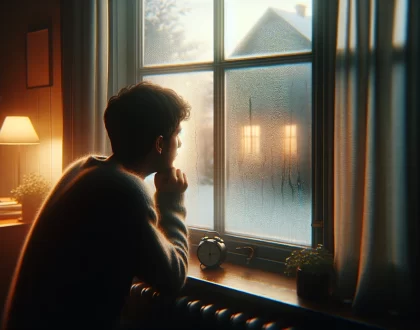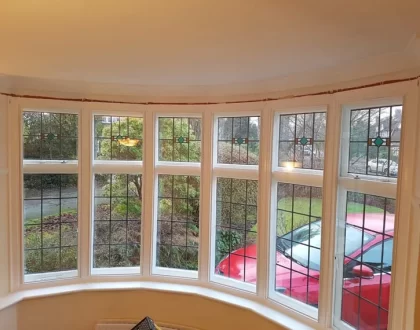Secondary Glazing for Leaded Windows: Types, Installation & Benefits

Leaded windows are a traditional feature of heritage homes. With a rich history dating back centuries, it’s no wonder that many homeowners consider leaded windows as the defining feature of their property.
Unfortunately, the beauty of their traditional design also comes with some downsides. That’s particularly true for thermal insulation. Secondary glazing for leaded windows is a popular solution that can warm your home in the winter – whilst also preserving the authenticity of your original windows.
What are leaded windows?
Leaded windows are a historic style of decorative window that features small sections of glass, also known as quarries, that are supported by lead cames. Cames are the divider bars which separate the quarries. However, the leaded effect on some modern leaded windows is achieved by simply painting lead onto the surface of the glass.
Also known as “leadlights”, leaded windows have been crafted for over a thousand years. The earliest examples of these historic windows stem from the Roman and Byzantine eras, but the style gradually rose to popularity during the Middle Ages. At this time, larger sheets of glass weren’t available, and the “diaper” shaped panes gave a high level of stability to leaded windows, making them a popular choice.
With the advent of sash windows in the late 17th century, leaded windows went out of fashion. However, the Gothic Revival later restored the popularity of leaded windows, which have remained a much-loved decoration for traditional-style homes.
Leaded windows or stained glass windows?
These terms are often used interchangeably, but there is a slight difference between the two. For a window to be considered “leaded glass”, it needs to be supported by lead caming. Meanwhile, “stained glass” specifically refers to the more ornate, coloured decorative glass windows found in churches. However, leaded glass can often feature coloured glass, and stained glass features lead caming, so there is clear overlap between the two terms.
Types of secondary glazing for leaded windows
Ultimately, the best type of secondary glazing for leaded windows will vary depending on the type of windows in your home…
Hinged casements
If you’re looking for an unobtrusive option, a hinged casement system is a perfect choice. Without transoms or mullions, you’ll have an unobstructed view and maintain the traditional appearance of your leaded windows.
Fixed inserts
One of the most simple types of secondary glazing for leaded windows is a fixed insert. These are a brilliant choice for areas that have minimal space to install a secondary panel, for example, on a door.
Lift out windows
These are an incredibly cost-effective choice. Lift out secondary glazing is perfect for windows where limited access is required, such as a decorative leaded window.
Horizontal sliders
Horizontal sliders are a very popular option. That’s down to their versatility, as they can be used in all types of property. The panel sizes can also be tailored to the primary window structure.
Bespoke secondary glazing
Many leaded windows feature unique designs and shapes. In these cases, bespoke secondary glazing for leaded windows is the best option. Clearview has a wealth of experience creating and installing bespoke secondary glazing for modern and traditional homes.
Installing secondary glazing for leaded windows
You might like the idea of secondary glazing for leaded windows, but the thought of installation can be off-putting. Will it mean weeks of disruption and mess?
The answer is no. At Clearview, we can install your secondary glazing in no time and with minimal disruption. We install windows for domestic customers within a 50 mile radius of our Sheffield head office. If your property is in our area, why not get in touch for a quote today?
Live outside of our installation area? Or, maybe you’d just like to install your own secondary glazing? Fortunately, we also have fantastic DIY options for you! Our premium DIY kits can be tailored to your windows, and are quick and easy to install.
Benefits of secondary glazing for leaded windows
Thermal insulation
Perhaps the most well-known benefit of secondary glazing is thermal insulation. By installing a sealed secondary panel, you could potentially improve your energy efficiency by over 60%. That can mean savings of up to 15% on your energy bills! If thermal insulation is important for your home, make sure you choose Low E glazing for increased insulation performance.
Soundproofing
As well as thermal insulation, secondary glazing for leaded windows can also help to keep unwanted noise out of your home. Creating the widest gap possible between the two glazing panels, as well as selecting acoustic glass, will help to maximise the soundproofing properties.
Condensation prevention
Secondary glazing can also help to prevent condensation from forming on your windows. Condensation often forms on single-glazed windows because of their cold interior surface. This attracts moisture, eventually turning into condensation. The insulating properties of secondary glazing prevent the surface of your windows from becoming cold, stopping condensation at its source.
Security
Your home is your fortress, but single-glazed windows are often thin and flimsy. Adding a secondary panel of glass makes it harder for intruders to enter your property, especially as we offer 4mm toughened glass as standard.
Maintaining character
Leaded windows are a beautiful decorative feature within traditional homes, so it’s natural that you’ll want to preserve their appearance. Installing secondary glazing ensures that your home receives all the benefits of modern glazing without losing the visual effect of your leaded windows. That’s especially important if your property is a listed building, as double glazing is not an option for many of these properties.
Preserve your leaded windows with secondary glazing
Leaded windows create a striking visual impact in any home. Unfortunately, they can also let cold air or external noise into your property. Secondary glazing for leaded windows can provide the best of both worlds, giving you the benefits of modern glazing without disrupting the appearance of traditional windows.
With over 20 years of industry experience, Clearview’s secondary glazing installation is quick and easy – and there’s minimal disruption to your home. Prefer to DIY it? Our high-quality DIY secondary glazing kits arrive ready to install.
If you’d like to know more, why not get in touch with our helpful team? Send us an email at [email protected] or give us a call on 0114 294 5018.
Recommended Posts

How can I stop condensation?
06/02/2024


